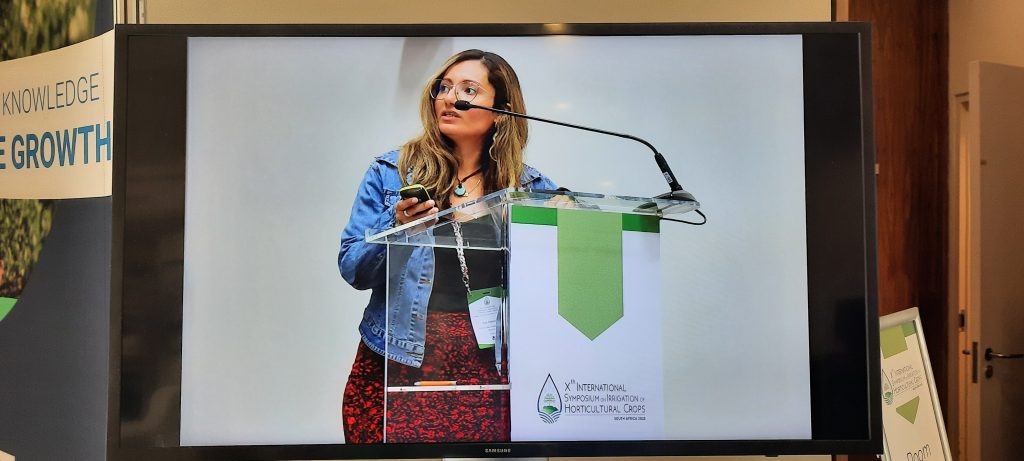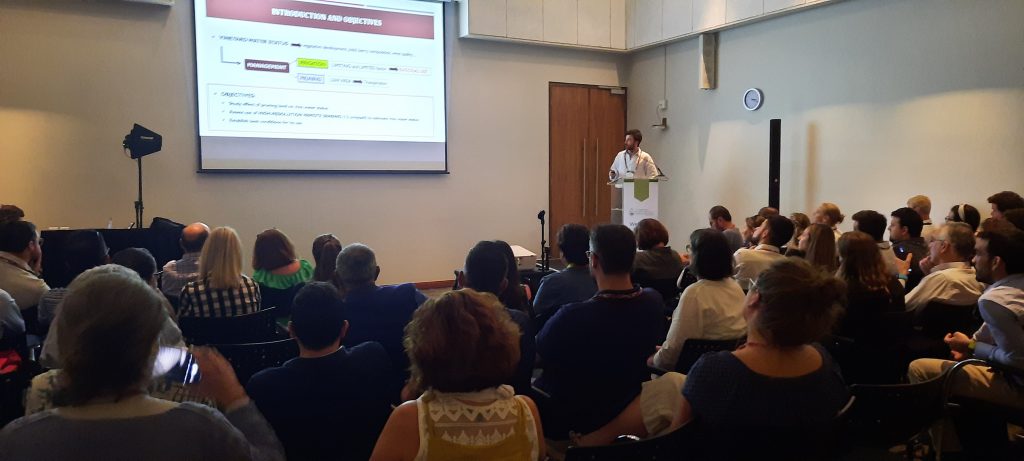Entre el 29 de enero y el 2 de febrero de 2023, los investigadores del CEIGRAM Luz Atencia Payares y Juan Nowack, participaron en el Xth International Symposium on Irrigation of Horticultural Crops, que se llevó a cabo en la ciudad de Stellenbosch, en Sudáfrica.
Al Congreso también asistió la investigadora del CEIGRAM y Profesora de la ETSIAAB María Gómez del Campo, quien participa en las investigaciones de Luz y Juan.
El trabajo presentado por Luz Atencia Payares fue el siguiente: «Soil vineyard variability evaluated with multispectral sensors on board of UAVs«.
A continuación un breve abstract de su investigación:
The differences in physical and chemical soil characteristics determine plant variability when vineyard is homogeneously managed (i.e., pruning, training system, irrigation, fertilization). Water storage capacity determines vine growth and production under deficit irrigation. The multispectral cameras on board unmanned aerial vehicles (UAVs) provide high spatial and temporal resolution data necessary to detect specific canopy information that helps to determine the complexity of vineyard agroecosystems. This work is focused on assessing the influence of soil variability on crop development through vegetative indices (VIs) obtained with cameras installed on UAVs. This study was carried out in two areas of a commercial vineyard in Yepes (Spain) with different types of soil in terms of effective depth, and texture. During 2021 agronomic parameters like canopy size (profile) and yield were measured. Data from multispectral camera were obtained on 3 dates (25 June, 20 July, and 19 August) and VIs (NDVI, RVI, and OSAVI) were calculated. Soil properties determined vine vegetative development and yield. The greatest vegetative development and yield of vines occurred in vines grown under deeper soils with a higher percentage of clay. The Vis were significantly different between vines cultivated in different soils. RVI showed the largest differences between vines. These differences were higher on the first flight (25 June) when grapes were at pee-size, suggesting that the phenological stage plays an important role when monitoring the vineyard variability with remote sensing.

Por su parte, el investigador Juan Nowack, presentó el trabajo «Use of remote sensing to estimate plant water status caused by different pruning strategies in Merlot vineyards in central Spain».
A continuación un breve abstract de su investigación:
Spain counts roughly 941.000 hectares of vineyards, of which 41% are grown under irrigation systems. Water status is a relevant parameter in grapevines as it affects yield, fruit composition and wine quality. Water stress reduces photosynthetic activity and vegetative growth and limits berry ripening. In addition to irrigation management, pruning determines plant water status due to its effects on leaf area. This study aims to assess the use of high-resolution multispectral imagery (0.12 m/pixel) to estimate plant water status through different Vegetation Indexes (VI) and evaluate which is most suitable for determining it. Another objective is determining if SWP-VI relations can include vines under different pruning management. This work was carried out in a commercial Merlot vineyard in Yepes (Toledo), an arid area in central Spain where rainfall and irrigation water availability is scarce. The vines were established in 2002 and arranged on a trellis with a plantation spacing of 2.6 x 1.1 m. Two different pruning strategies are carried out: mechanical pruning and no pruning. The SWP measurements were taken at two different solar times (9:00 and 12:00) using a pressure chamber. Images were obtained using a multispectral camera mounted on a UAV at the same times as the field SWP measurements were taken, and different VIs were calculated (NDVI, RDVI, TCARI, OSAVI and TCARI/OSAVI). Results have shown that the no-pruning system presents lower values of SWP, therefore, higher levels of water stress throughout the different days and measurements. These differences were also found in the values of the VIs. Non-pruned vines presented lower values of NDVI, RDVI and OSAVI than pruned and higher values for TCARI. Linear regressions between SWP and NDVI, TCARI and RDVI presented the tightest correlations at noon solar time (R2: 0.82 and 0.81), although OSAVI and TCARI/OSAVI showed significant correlations too. Solar noon flights achieved higher R2 values on all evaluated VIs.

Desde el CEIGRAM-UPM queremos dar la enhorabuena a los dos investigadores y a la Profesora María Gómez del Campo por su participación en este Congreso Internacional. ¡Y seguiremos atentos a sus trabajos de investigación!
